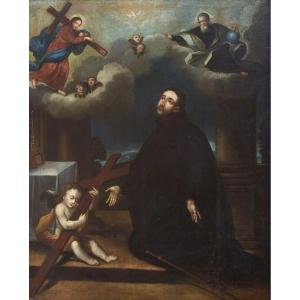Represented here is one of the artist's dearest subjects, namely the depiction of half-figures of saints or philosophers investigated with crude realism; here we can also see our artist's predilection for a smoother, more softly shaped and more vibrant pictorial body.
The compositional scheme of this work faithfully reflects the precepts of the time with an 'almost frontal setting of the figure and with the light conceived in the strictest Caravaggesque tradition, with a light source coming from the left, which makes both the noble head and the very accurate hands stand out against a dark background, shaded on the right in a lighter halo; here we can easily see the artist's inclination and desire to capture in the portrait the character of the character and his attention to an emotional and sentimental rendering of the image through a painting, which exudes a deep humanity and great moral strength without ever reaching a decorative formalism, endowed with both great naturalism and of an intimate and sorrowful participation for a humanity marked by age and suffering.
Analyzing a few details of the work such as the epidermal beauty of the pictorial material on the wrinkled forehead and the refined definition of the complexion and the superbly painted hands in comparison with the humble clothing we can even address the work around the 1740s. when Francesco Fracanzano embarked on the path of a more observant realism typical of his great master and mentor Jusepe de Ribera, although we can already glimpse new chromatic turns far removed from his youthful period when naturalistic rigor yields to the flattery of a more tender and refined pictorial palette as revealed by the more accurate conduct of the various veils in this painting.
I may add that the authorship of this work to Francesco Fracanzano lies not only in the drafting of the work, its colors and its representation, but finds confirmation in numerous works by the artist himself where, in any case, his imprint is known.
We can find the same artistic sense present here in other works by the same painter such as The Return of the Prodigal Son, Lot and the Daughters found in the Monopoli Cathedral, the Bacchanal in the Fogg art museum in Cambridge, the inebriated Silenus found in the Prado museum in Madrid, and Ecce Homo now in the Morton B. Harris collection in New York.
The paintings and works of art published here are my exclusive property and therefore are always available to be viewed, by appointment, in my exhibition sites located in Sanremo and Brescia.
This item , like all our objects, is sold accompanied by a photographic certificate FIMA of authenticity and lawful origin; this document identifies the object by adding more value to the article.
We take care and personally organize the packaging and shipping of our items with insurance all over the world.
Mr. Riccardo Moneghini
Art Historian











































 Le Magazine de PROANTIC
Le Magazine de PROANTIC TRÉSORS Magazine
TRÉSORS Magazine Rivista Artiquariato
Rivista Artiquariato